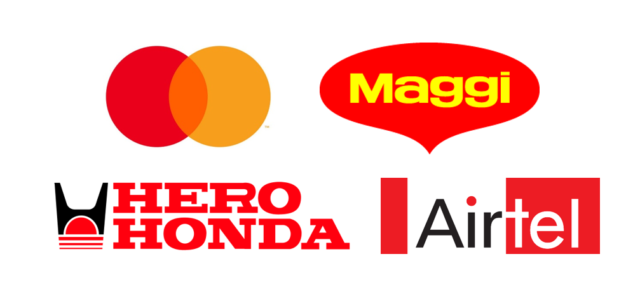
What do you think is common between Hero Honda, Maggi, Mastercard and Airtel?
One similarity, of course, is their dominant position in their respective categories. With category leadership, often, comes another challenge – cultural barriers. Especially when the category is relatively new and the leader’s task is to drive adoption.
New categories represent new value systems. They catch on because these value systems are in line with those emerging in society. However, since the new threaten the old and entrenched values, they can face resistance. Which in turn can stifle category adoption.
This is where smart category leaders often adopt the contradictions strategy. Let’s take a look.
Maggi: Convenient love
The instant noodles brand launched in India in the early ’80s, with the promise of convenience for the homemaker. This aligned with her emerging need for freedom from the kitchen (Incidentally, Maggi’s launch came close to the emergence of TV soap operas in India with Hum Log, creating her need for TV time in the evenings. Maggi was one of the primary sponsors). However, it also ran against the strong culture of cooking (and the skill and effort behind it) being a symbol of her identity as a good mother. The simplicity of Maggi had the potential to make her redundant, or at least look like she was cutting corners by adopting it.
This is where Maggi’s adoption of the contradiction strategy came into play. Instead of underlining convenience, Maggi’s advertising emphasised mother’s love, effort and skill in making it. In our analysis of nearly 25 years of Maggi’s communication, rarely did the brand replace the mother suggesting kids could make it on their own (even though it was common practice in reality). Instead, it showed elaborate cooking moments with mothers painstakingly adding their touch while making Maggi. The aspect of speed (2 minutes) was justified more by linking it to the child’s impatience rather than mothers need for lesser time in kitchen.
Remarkably, an item that needed simply few minutes of boiling for preparation became a symbol of mother’s cooking. Even as the product offered convenience, the brand offered comfort of home food, nostalgia and mother’s love. No wonder college hostelers across the country find solace in Maggi when missing home and home food!
Hero Honda: Collective emancipation
A few years later, entered a slew of Indo Japanese brands of 100 cc motorbikes. They looked sleek, promised greater fuel efficiency, but most importantly symbolised the emerging sense of individualism in the country. These bikes were challenging scooters, the predominant mode of transport aligned to the entrenched collective image of a responsible family man (depicted by Bajaj). Bikes, classically represented the choice of the rebellious, free man.
Even as the young Indian male yearned for the freedom, he was tentative about too overt an expression of the same in society. It would symbolise poor values and upbringing. Not good in a still largely collective society where many times, the money for buying the bike came from his father and needed his approval.
Hero Honda reflected this understanding by not only offering a sensibly designed bike (sober, not overtly macho) with the promise of high fuel efficiency. Over time its communication depicted the brand user’s collective identity – as a good, obedient son totally in sync with dad’s choice of the bike or a good father/family man. Quite the opposite of what the category codes demanded.
Indeed, the brand that did follow the codes faithfully – Yamaha never managed to achieve much significance in terms of market success.
Mastercard: Meaningful consumerism
The emergence of credit cards heralded yet another set of value systems. Where fulfilling desires first and paying later started to become acceptable. Families in India were transitioning from the joint to nuclear structure. Higher incomes with smaller families (the rise of DINKs) meant there was more money to fulfil one’s desires.  This emergence of a consumption oriented, materialistic culture threatened human emotions. As the urban yuppie embraced a life of punishing work schedule to afford a dream lifestyle, credit cards became a symbol of this new culture.
This emergence of a consumption oriented, materialistic culture threatened human emotions. As the urban yuppie embraced a life of punishing work schedule to afford a dream lifestyle, credit cards became a symbol of this new culture.
Even as Visa went with the flow, promising Visa power, Mastercard took the opposite route. It celebrated the primacy of sentiments that money could not buy. Assuaging the audience that their pursuit of consumption was not devoid of richer meanings.
Airtel: Nomadic intimacy
A few years later down the road came the magic of mobile telephony. By literally cutting the cords in connections, mobiles promised mobility of a completely new kind. From the shared family phone, the world started moving to personal mobile phones. Part of this was the culture of rising physical mobility of family members. Youngsters moving to metros for careers, away from parents, husbands and fathers on frequent tours away from wives and kids. While in practice, mobile phones were being adopted to fuel professional upward mobility, emotionally the bigger opportunity lay elsewhere.
Airtel embraced the promise of intimate connections even as you were away from your loved ones. Over the years, it focused on families of all kinds – generations separated by migration, fathers away on work sites, husbands leaving on office tours. Vodaphone too adopted a related stance by celebrating innocence in connection (threatened by mobility and pursuit of personal progress) through its memorable boy and pug campaign.
These are but a few examples of brands creating their meanings as contradictions. In doing so, while riding the emergent wave as categories, they simultaneously assuaged the threat their entry symbolised.
Today, as many new categories enter the market, which interesting contradictions do you spot?


